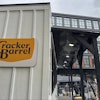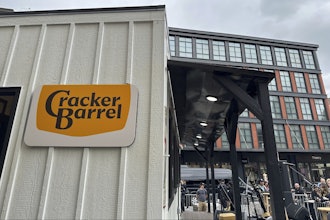Globalization and digital technologies are changing businesses, especially as companies look to find new ways to amplify growth and expand into new markets. To do this, companies must create efficiencies in their supply chains and be able to keep up with complex and ever-changing supply chain dynamics. So, the question is: How has labeling changed with digital transformation and the new global supply chain model, and how can labeling solutions meet the needs of today’s food and beverage manufacturers?
Businesses that leverage innovation and embrace change and run their supply chains in a collaborative fashion are the ones that will succeed in this new landscape. As always, businesses must be able to achieve high levels of agility, consistency, control and transparency to prosper. This is why it’s critical to identify, understand and measure how labeling has a strategic impact on your supply chain and your company’s business growth.
To get a pulse on the impact of labeling on today’s supply chain, Loftware conducts an annual survey. Here’s what we found:
Trend 1: The Definition of Enterprise Labeling is Evolving
Today’s Enterprise Labeling offers a wide range of capabilities and benefits, providing dynamic data, content and artwork, as well as the flexibility in labeling to meet all types of unique requirements in different industries and across global supply chains.
Workflow and Approval Processes are Essential
Manual or disconnected workflow processes introduce additional cycle times and risk to the processes of reviewing and approving labels, content and artwork. Reducing cycle times on labels from months and weeks to days can represent a huge cost savings and increase agility when new products are introduced or major changes to labels are needed.
Content Management is Critical
As the amount of content (data, translations, images, etc.) required for labeling increases, companies question where that data should reside. Transactional and master data is most often sourced from ERP, WMS, SCM and PLM applications, but other elements used specifically for labels and packaging do not reside in these systems. However, these elements still need to be managed, reviewed and made available in real-time for when labels are being printed.
Enterprise Labeling and Artwork Management Converge
There are many common requirements between labeling and artwork management so companies are looking to address those combined needs. This includes the ability to manage content including images, artwork, warnings, translations and phrases. It also means managing workflow and dynamically printing both labels and packaging artwork.
Trend 2: Centralized Control with Continuous Uptime is Imperative
In the past, global companies needed to choose between deploying labeling systems centrally to maintain consistency and streamline management, versus deploying locally to maximize uptime and reduce risk. Companies are looking to manage labeling centrally and ensure alignment with corporate standards while enabling geographically dispersed locations to run autonomously without relying on an uninterrupted connection to the “mother ship.”
Companies Require More Labeling Control and Consistency
Today’s companies are realizing that they can centralize and standardize with one Enterprise Labeling solution and still drive labeling from a range of local facilities. Fortunately, the advent of “multi-site” functionality enables centralization, empowering businesses to control labeling and make decisions centrally, while also meeting the demands of their localized facilities.
Business Continuity Demands Labeling Failover
The ability to have labeling continuity with failover from a central to a local instance is paramount in allowing remote locations to continue without disruption. The power of multi-site deployment capabilities enables labeling to fail-back to the central instance once the connection is re-established, then relevant transactional data can be synchronized between the central instance and any impacted facility.
Remote Facilities Look to Manage Labeling More Independently
In many cases, remote sites need to manage labeling with a degree of autonomy at manufacturing plants, warehouses and distribution centers. These facilities often have location-specific nuances in labeling that cannot be understood or managed by headquarters. Multi-site capabilities allow corporate to support regional deployments and ensure consistency while the remote sites get the location-specific autonomy they demand.
Trend 3: Analytics is Bringing Improved Visibility into Labeling Processes
Companies today understand the value of obtaining important business metrics. For years now, companies have used Business Intelligence (BI) and reporting solutions to improve business operations. Given the mission-critical role of labeling, it’s only natural that business is expressing the growing need for advanced analytics and reporting from their enterprise labeling solution.
Taking Labeling One Step Further with Interactive Analysis
When it comes to labeling, there has traditionally been limited reporting options to assess activities and drive efficiencies. However, companies are beginning to demand the tools needed to understand and optimize their labeling environment. Businesses are looking to go beyond simple reporting and leverage interactive dashboards so they can drill down to get specific insights into labeling trends and activities. They are seeking real-time visibility that enable them to make better labeling decisions and allow better planning, so they can quickly adapt to changing business scenarios and become more competitive.
Analytics are Driving Improvements to Labeling Processes
Having access to advanced analytics and real-time reporting provides visibility into constantly changing and vital information including labels, printers, print jobs, users and audit data. Administrators now want BI to monitor labels printed across facilities to ensure the quantity of labels printed are in line with the expected output. They are also looking to use this insight to establish better maintenance schedules for printers and to analyze trends in label production to fine tune labeling environments.
Audit Reporting is Critical for Regulated Industries
Stringent regulatory requirements include heightened demands for accuracy and auditability. This enables them to comply and easily provide the required data. This is especially meaningful for customers with validated environments that demand real-time access to a complete view of all user labeling activity and changes. Ultimately, BI enables users or auditors to have complete visibility so they can see the status of labels, workflows, print requests, configurations and users’ actions from the process of creation to approval to publication to print.
Trend 4: Cloud Technology is Disrupting Labeling
Businesses are embracing the cloud as a preferred deployment method for enterprise applications. Not surprisingly, companies are looking to integrate their labeling with their cloud-based enterprise applications and even deploy labeling solutions in the cloud. Cloud-based labeling simplifies maintenance and support, reduces cost and IT involvement and expands global use. However, cloud-based labeling must not sacrifice the flexibility and print performance that are both essential.
Cloud Deployment Offers Seamless Upgrades, Maintenance and Scaling
Businesses today are moving more of their IT This move to the cloud also impacts labeling as companies look for labeling solutions to be built for cloud deployment and to integrate with other cloud-based applications.
Need for Certified Integration with Cloud-based Enterprise Applications
Large enterprise application companies like SAP, Oracle and Infor have fully embraced the cloud. Consequently, their customers are looking to see how labeling will be addressed as they move from on premise deployments to cloud-based. These customers understand the benefit of moving to the cloud but often fail to think about how labeling processes will be affected. Not surprisingly, businesses expect to be able to print the same labels they print today, with the same printers and the same performance.
Native Print Drivers Needed for Increased Performance
Printing from cloud-based applications requires a different approach to ensure these expectations continue to be met. Deploying an enterprise labeling solution designed for cloud printing using native drivers enables organizations to reduce the size of their print streams delivered over the internet and dramatically increase print speed. The key here is to simplify the printing process, reduce the moving parts in the labeling solution and support a broad set of printers across locations.
Trend 5: Labeling Demands More Attention
As labeling has become vital for global operations, many more people, groups, departments and regions are becoming involved in labeling. Each of these constituents have their own interests and requirements that must be appropriately represented on the label. For this to happen, individual departments need to collaborate across the enterprise to ensure accuracy, create efficiencies and streamline mass label changes.
Multiple Departments are Now Responsible for Labeling
It’s becoming increasingly important to have different stakeholder requirements addressed and managed. Using “layers” to segregate and manage the real estate on a label enables better control and consistency over the label design process by allowing different groups to “own” and control specific layers of a label to streamline approvals and mass updates. The use of layers can also improve label consistency and accuracy, while reducing the time and effort needed to manage large numbers of label templates.
Globalization of Labeling Creates Added Involvement
As businesses extend their reach across the global supply chain, they are looking to standardize labeling solutions and maintain labeling consistency. However, each region has its own labeling requirements and resources involved in the labeling process. As companies scale, they must consider how to efficiently deploy and maintain labeling solutions while meeting the needs of stakeholders in multiple markets and regions.
Regulatory and Customer Requirements Drive Labeling Involvement
Labeling has become more complex as companies must meet critical customer and regulatory requirements. This has resulted in more stakeholders getting involved in the labeling process and recently companies have established a dedicated labeling function. This role offers oversight to ensure that the business is adhering to both regulatory guidelines in each international region, while meeting unique customer demands throughout the company’s global supply chain. At the same time, this global labeling function ensures that designated roles and departments are responsible for supporting corporate brand standards, while minimizing the threat of mislabeling.
Josh Roffman is VP of Product Management at Loftware.























